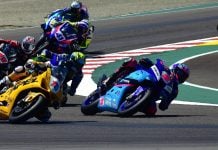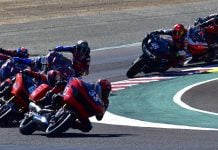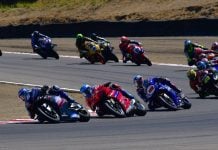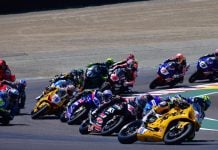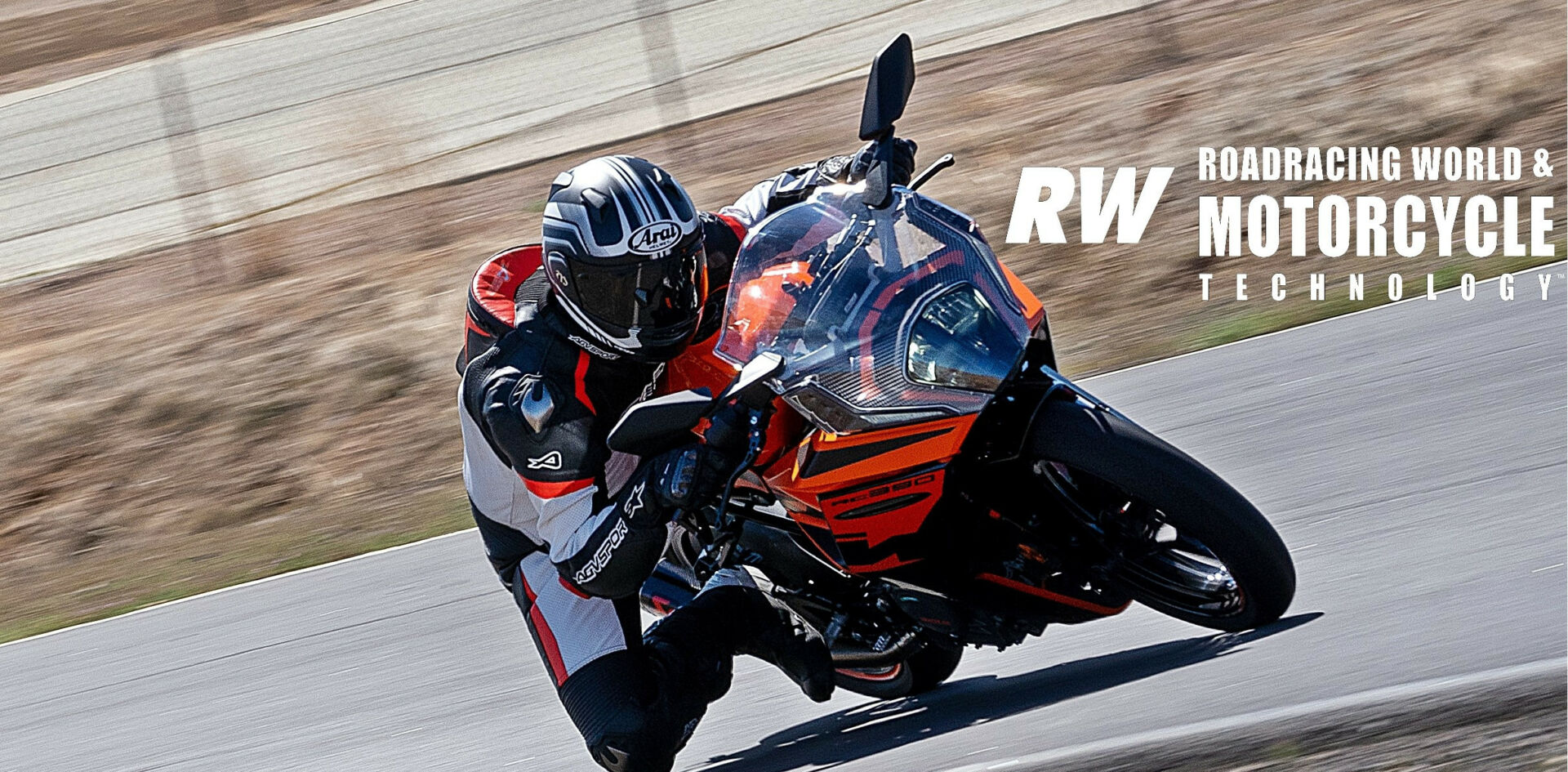Copyright 2022, Roadracing World Publishing, Inc.
By Michael Gougis
KTM’s RC 390 has always served as a solid and rapid platform for an ultralightweight racebike. For its 2022 update, the company put the revisions into the hands of Shaun Anderson, an engineer who also races in the Isle of Man TT events. So it’s not surprising that the bike is even more track-ready than before, and offers features simply not found elsewhere in this market segment.
KTM introduced the new model to North America media in the best possible way: It rented a racetrack, brought along former AMA Pro Racing National Champion Chris Fillmore (now KTM Road Racing and Flat Track Manager) to supervise, and turned journalists loose on a fleet of the new little sportbikes.
Several hours of ripping around at the (mostly) repaved 1.8-mile Streets of Willow circuit revealed a motorcycle that has all of the qualities that made the prior generation RC 390 so much fun at the track, as well as improvements that really have moved the goalposts in the category.
Tech Overview:
The 89mm bore by 60mm stroke single-cylinder engine remains essentially unchanged from the previous model, but an airbox that moves 40% more air means the torque output is slightly higher. The 373cc engine still makes a claimed 44 horsepower and redlines at an indicated 10,000 rpm.
The chassis has been changed significantly to increase lateral flex and feel on the track, as well as to reduce weight. The company claims the new steel trellis chassis weighs 3.3 pounds less than the previous model’s frame, and now features a bolt-on subframe that can be replaced for track use. Weight savings continue with the wheel assemblies (wheels, front axle, brakes) losing a combined whopping 7.5 pounds of unsprung mass.
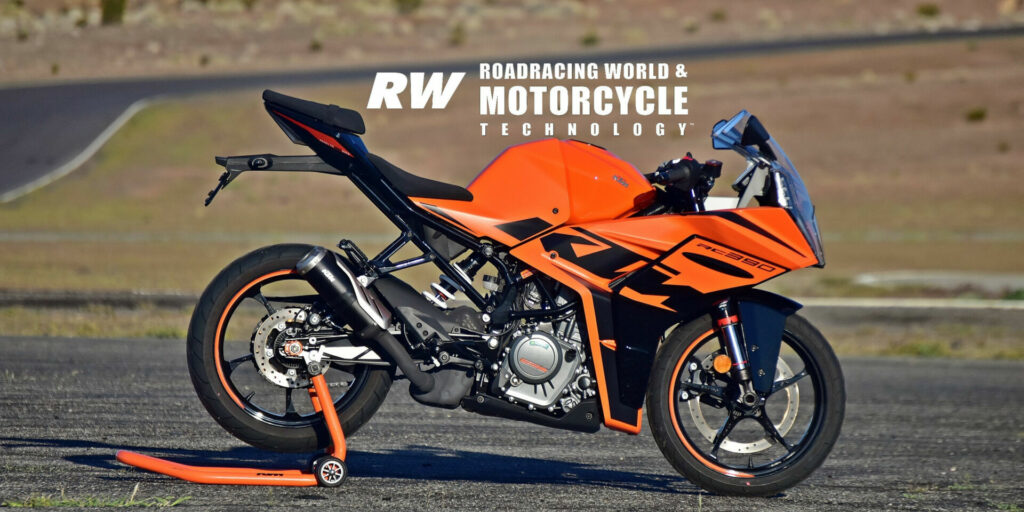
The inverted 43mm WP Apex cartridge forks now feature adjustable compression and rebound at the front, although preload is not adjustable. A single WP Apex split-piston shock offers rebound damping and preload adjustment at the rear.
Electronics take a big step forward, with a 3-axis IMU providing cornering and deceleration data sufficient to operate a simple on/off traction control system and ABS, and both are lean angle sensitive. The ABS operates either front and rear brakes simultaneously or the rear can be switched off in Supermoto mode. In addition, the RC390 offers clutchless up- and down-shift operation, although that feature comes at an additional cost. The six-speed gearbox transmits power through a power-assisted slipper clutch.
Handlebars are slightly higher than on the prior model, but these can be adjusted downward on the fork tubes for a racier riding position. The bodywork is larger for better aerodynamic performance and is easier to get on and off, because racers are constantly fiddling with their bikes!
Little things have changed to make the bike easier to live with. The tank is nearly a gallon larger than the tank on the older model, meaning fewer stops for fuel. The shifter and brake pedals fold in case of a tip-over. The larger windscreen provides better protection for the rider. The levers are adjustable.
And as always, KTM has a pile of performance parts available. Some of the test bikes were equipped with billet, folding levers; solid-mount racing rear-set controls; and lightweight sprockets. One machine was equipped with a kit WP shock with more adjustments and a fork kit with adjustable preload.
It’s safe to say that this machine changes the ultralightweight sportbike market segment. It’s the most sophisticated machine in the class, and it’s priced competitively with the others it races against in Junior Cup classes around the world.
But how race-ready is it?
Riding On The Racetrack
Throw a leg over–and I do mean throw, since the seat height is raised to 32.4 inches–and it’s an easy reach to the flat clip-on handlebars. There’s a reasonable amount of legroom, even with the racing rearsets. Thumb the starter and the bike settles into an easy idle, with little in the way of vibration. The Thin-Film Transistor dash is easy to read and adjusting the electronics is simple and intuitive.
The clutch pull is light. The quickshifter required deliberate motion at the foot, but if I was solid with my shifts it worked, and together with the slipper clutch it made corner entries significantly easier. Just sit up, brake and start stomping down on the shift lever. And if you’re in a little too hot, the ABS gives you the confidence to simply hang onto the lever a little longer, even after you’ve tipped the bike in and you’re angling toward the apex. Nothing like a little electronic safety net when you’re refining a skill like trail braking!
The revised bodywork and windscreen did their jobs. It was easy to tuck in and stay out of the wind, all the way up to the indicated 100 mph that I saw at the end of the back straight. The flat angle of the bars made hanging off a bit uncomfortable, but there was room for my 5′ 10” frame to tuck all the way in.
For a 373cc Single, there’s reasonable power, and the bike pulls cleanly from the bottom and spins to redline quickly in the first three gears. It starts to feel a bit breathless at the top end in fifth, and I didn’t spend much time in sixth.
The light weight and especially the lighter rims make the machine very easy to flick. It did take me a while to get used to how much or little effort was needed on the handlebars and through the pegs to put the bike where I wanted it to go. But whatever I wanted, the bike delivered it quickly. The famous Willow breeze was out in full force, making it a bit harder to be really precise with selecting lines, so I rode with a bit of the track in reserve. Still fun, and the bike stayed nimble as I picked up the pace.
The suspension was surprisingly well sorted, the forks rigid and well damped, easily well enough to play around at Streets, and a bit of vagueness at the rear was cured by adding damping and preload. I’d read some of the overseas reviews in which the test rider praised the shock’s behavior and was a bit skeptical. It’s not a race shock, but it really was noticeably better than I expected on an ultralightweight. Once the bike was set and loaded in a corner, it was dead stable.
My legs were sore–like, more than I expected them to be–the next day. Looking back, I think it’s because I took full advantage of a beautiful day, an open track, and a bike that was really, really fun on this particular circuit. The core of KTM’s little sportbike remains entertaining, and the electronics upgrades add to the usability of the package, especially for younger riders and those learning the ropes of track riding. I’ve got a test unit in the garage, and I don’t think it’s seen the last of its time on the track with me aboard!
Suggested retail starts at $5,799 and the RC390 should be in dealer showrooms by the end of May.


